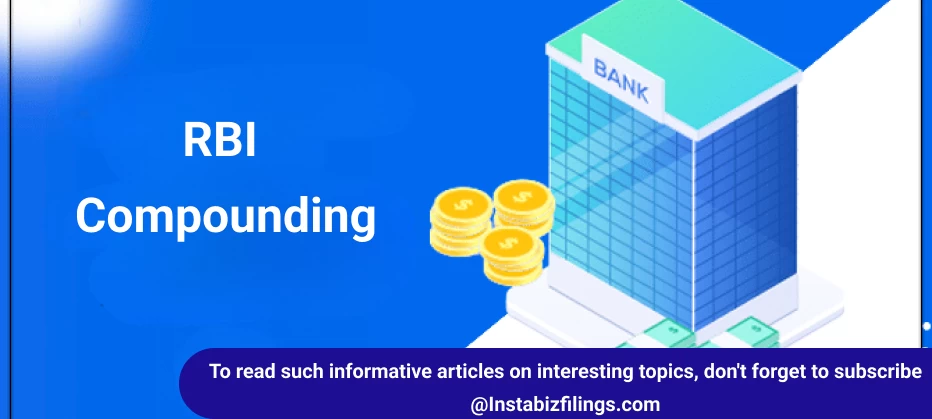
RBI Compounding
October 3, 2025 by Team Instabizfilings
RBI Compounding is the process adopted by the RBI where it allows entities, such as banks and financial institutions, to clear certain regulatory violations or lack of compliance in exchange for paying a compounded amount in the form of a fine or penalty. Simply put, it allows entities to cure their violations without recourse to legal proceedings, as long as they do so within the prescribed framework.
The RBI applies the compounding system as a means to encourage compliance with the law and its regulations. This article examines the concept, purpose, process, and other features of RBI Compounding in depth.
What is RBI Compounding?
RBI compounding means the settlement of a breach or default against the Reserve Bank of India's rules, regulations, and guidelines through the payment of a specified penalty. RBI determines the amount of this penalty, which is usually payable as a settlement fee in lieu of further legal proceedings like litigation or enforcement action.
The compounding facility is generally made available for more minor or technical breaches of RBI instructions, where the breach is not considered intentional or fraudulent.
Purpose of RBI Compounding
The RBI Compounding procedure has the following functions:
-
Encourage Compliance: Compounding helps entities comply with the laws by providing a method of settling violations without the prospect of extensive legal sanctions.
-
Resolve Minor Infractions: It enables entities who have committed minor offenses to dispose of them without being charged or otherwise prosecuted.
-
Promote Fair Practices: Through the imposition of penalties and fines, the RBI makes sure that banks and financial institutions adopt equitable and ethical practices, which strengthen the financial system in terms of trust.
-
Prevention of Systemic Risks: The RBI strives to make sure that regulatory abuses are addressed at the earliest, reducing the risk of something bigger occurring that could impact the stability of the financial sector.
-
Efficient Dispute Resolution: Compounding is an effective alternative to a lawsuit, accelerating the process and avoiding lengthy judicial wrangles.
Types of Violations Eligible for Compounding
RBI compounding covers routine violations that are not fraudulent or intentional but are in violation of the rules of the central bank. A few typical violations that may be covered under compounding include:
-
Non-compliance with Reporting Requirements: Failure to report on time to the RBI or other regulatory bodies, or reporting false or incomplete information.
-
KYC (Know Your Customer) Norm Violations: Non-compliance with customer identification and verification guidelines of the RBI.
-
Non-compliance with Prudential Norms: Violations in the areas of capital adequacy, asset classification, or provisioning norms.
-
Irregularities in Foreign Exchange Regulations: For example, non-compliance with regulations under the Foreign Exchange Management Act (FEMA) vis-à-vis maintenance of foreign exchange accounts.
-
Improper Loan Classification: Failure to follow the right classification of non-performing assets (NPAs) or restructuring loans as per RBI guidelines.
-
Non-adherence to Credit Policy Guidelines: Breaking rules concerning interest rates, loan provisioning, or risk management procedures.
The RBI Compounding Process
The compounding procedure of RBI enables institutions or persons who have committed an offense to seek compounding of the offenses. The following is a step-by-step description of the general procedure:
- Step 1: Detection of Violation
- RBI or other supervisory authorities become aware of the violation in the course of routine inspection, audit, or regulatory reporting. The offense may also be voluntarily reported by the financial institution itself.
- Step 2: Issuance of Notice
-
On finding a breach, the RBI normally sends a show cause notice or notice of violation to the defaulting party (i.e., bank, financial institution, or individual). This notice states the details of the breach and requests a reply from the offender.
- Step 3: Application for Compounding
-
After it is established that the violation has indeed taken place, the violator may approach the RBI seeking compounding. The application is made in writing to the RBI, explaining the violation and requesting settlement under the compounding rules.
-
The application should contain all pertinent details including:
-
Nature of the violation.
-
Amount involved in the violation.
-
Actions by the entity to rectify the violation.
-
Compliance activities after the violation.
- Step 4: Evaluation of Application
-
The RBI examines the application considering the seriousness of the violation, the past history of compliance by the entity, and corrective actions taken.
-
If the RBI finds that the violation is not too serious and qualified for compounding, it goes ahead and computes the compounding amount.
- Step 5: Compounding Fee Calculation
-
The RBI determines the fee of compounding depending on the nature of the violation, the financial consequence, and other factors. The fee is normally an agreed multiple of the sum involved in the violation.
-
The RBI may either apply a formula or implement a uniform percentage of the sum involved. In some instances, the RBI can also charge a flat fee.
- Step 6: Payment of Compounding Amount
-
Once the compounding charge is arrived at, the violator needs to pay the penalty within a specified time limit.
-
Payment of the compounding charge amounts to settlement of the violation and no further action is initiated.
- Step 7: Final Settlement
-
Once the payment is made, the RBI gives a formal notification that the violation stands settled and the compounding process is finalized.
-
By then, the entity is deemed to be in compliance with RBI regulations, and the issue is resolved.
Factors Influencing Compounding Amount
A number of considerations go into the calculation of the compounding charge. These could be:
-
Nature of the Violation: The severity of the offense, whether it is technical or more serious, determines the amount of penalty.
-
Duration of Non-Compliance: The longer the violation, the greater the penalty might be.
-
Intentional vs. Unintentional Violation: In case the violation was not intentional or due to neglect, the penalty can be less. On the other hand, intentional violations could face a greater penalty.
-
Amount Involved: For offenses involving money dealings, the transaction value or amount of non-compliance is usually taken into account.
-
Corrective Action Taken: If the violator has initiated corrective measures to correct the violation or avoid future violations, this would lower the penalty.
-
Past Compliance Record: Organizations with a positive history of compliance can be treated leniently with less severe penalties than violators who have committed several in the past.
Limitations of RBI Compounding
Though RBI compounding has many benefits, there are some limitations:
-
Limited Scope: Compounding is generally only applicable for non-fraudulent, minor violations. Serious offenses, such as fraudulent transactions, money laundering, or significant violations of RBI rules, do not normally qualify for compounding.
-
No Immunity from Legal Action: Although compounding puts the violation to rest in the case of RBI penalties, it does not extend immunity from other legal actions, such as criminal proceedings by law enforcement authorities.
-
Compounding Fee May Be High: In certain situations, the compounding fee can be very high, particularly for major violation cases, which can create financial burdens on the violator.
-
Public Disclosure: Compounding activities and parties involved, based on the type of violation, might be made public, which may tarnish the image of the institution.
Recent RBI Guidelines on Compounding
The RBI updates its compounding guidelines from time to time, particularly with respect to changing regulations, new compliance rules, and new risks. Some of the recent developments in RBI compounding are:
-
Simplification of Processes: The RBI has attempted to simplify the compounding process to make it less burdensome for financial institutions and individuals to approach and settle their defaults.
-
Sector-Specific Compounding: RBI has also put in place sector-specific compounding provisions for various sectors, such as banking, NBFCs, and foreign exchange regulations.
-
Enhanced Transparency: The RBI is now more transparent in the compounding process, making public settlement details and penalties to provide accountability.
Conclusion
RBI Compounding offers a convenient and cost-effective solution for banks, financial institutions, and individuals to settle trivial regulatory breaches without undergoing lengthy legal proceedings. By paying a compounding fee, organizations are able to terminate their problems, rectify non-compliance, and resume their activities.
It should be noted that though compounding is a less onerous option compared to litigation, it cannot be used as a substitute for sound governance and compliance with RBI regulatory guidelines. Organizations need to make sure that they remain in line with RBI regulations to escape penalties and retain the confidence of regulators, investors, and customers.
Please let me know if you require additional information or if you would like to look into any particular area of the RBI compounding process!
Disclaimer
The information provided in this blog is purely for general informational purposes only. While every effort has been made to ensure the accuracy, reliability and completeness of the content presented, we make no representations or warranties of any kind, express or implied, for the same.
We expressly disclaim any and all liability for any loss, damage or injury arising from or in connection with the use of or reliance on this information. This includes, but is not limited to, any direct, indirect, incidental, consequential or punitive damage.
Further, we reserve the right to make changes to the content at any time without prior notice. For specific advice tailored to your situation, we request you to get in touch with us.


